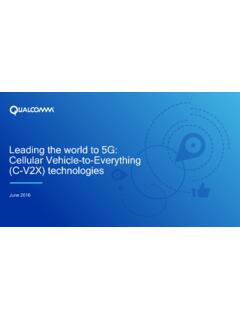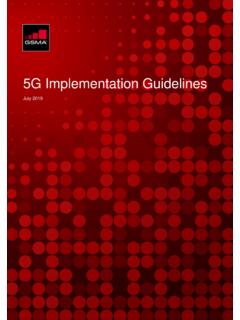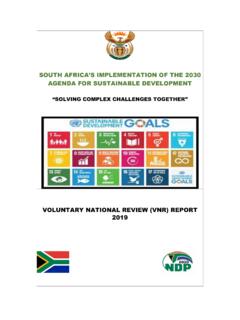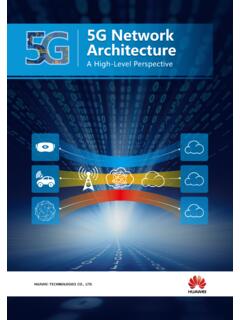Transcription of Transforming Telecom: Data-Driven Strategy for Digital ...
1 WHITE PAPERT ransform Telecom: A Data-Driven Strategy for Digital TransformationBy Hitachi Vantara and Ravi Kalakota, Partner, LiquidHub June 20192 ContentsExecutive Summary 3 Digital Transformation of the Telecom Industry 4 Digital Trends Transforming the Telecom Industry 5 The network of the Future: 5G Networks 5 Digital Media and Interactive Entertainment 6 Over-the-Top Streaming 8 Internet of Things (IoT) and Telematics 9 Smart Software-Defined Networks (SDN) 9 Transformation Agenda: Five Key Strategic Initiatives for Every Service Provider 10 Establish Data-Driven Customer Analytics Capabilities 11 Digitize the Order Management Process 11 Innovate Around the Customer Experience 12 Streamline the Application Landscape 13 Standardize and Automate the IT Infrastructure 13 Summary and Next Steps 14 Data-Driven Digital Transformation, Powered by Hitachi Vantara 143 Executive Summary The digitization of content and services has increased choice, innovation and competition.
2 As a result, it s no longer business as usual for telecom providers. The industry is at a crossroads. Like companies in most industries, telecom companies face a new landscape of competitive challenges and opportunities , thanks in large part to an increase in global mobile data traffic, driven by a strong growth in smartphone subscriptions and a demand for data-intensive applications, such as video (see Figure 1)1. For many years, telcos have dealt with network and service convergence within their own industry. The new wave of change, however, is far broader. It is a global dynamic in which industries are overlapping and colliding, and value chains are being redefined. Players are being brought together as both competitors and collaborators across tradi-tional boundaries of industry and technology.
3 No organization is immune to disruption, and the best defense remains innovation. This white paper will start by examining the current landscape, in particular, some of the major trends that are causing dramatic changes in the industry. These trends are disrupting established value chains and business models while offering nontraditional Figure 1. Global Mobile Data Traffic2 (exabytes per month)1 Source: = Central Europe, Middle East and Africa4growth prospects and new opportunities that were unheard of just a few short years Transformation of the Telecom Industry Customers, channels, content and competitors are all becoming Digital , resulting in a whole new ecosystem of value.
4 The Digital transformation journey is so fundamental that it requires changing the DNA of every communications ser-vice provider. The telco industry is going through massive structural changes. The rapid development of disruptive technologies (such as 4G LTE), messaging services (such as WhatsApp, WeChat), and products (such as over-the-top Netflix streaming) has eliminated many of the traditional distinctions between wireless, cable, internet and local and long- distance communication services. It has brought new competitors to telephone companies, cable companies, wireless service providers, satellite providers, application and device providers, and providers of Voice over Internet Protocol (VoIP) services.
5 The key market trends: Convergence of previously discrete markets (for example, content, TV, broadband, wireless and cable). Exponential growth of data volumes (for example, streaming apps in the cloud). Digitization: More and more services are moving to the cloud. New customer behavior patterns (for example, cord-cutting and binge watching). While these changes have enabled companies to offer new types of products and services, they have also allowed providers to broaden the scope of their own competitive offerings. For instance, the large service providers (including Verizon, AT&T, Sprint, Comcast, Vodafone, BT and T-Mobile) as well as various regional wireless service providers face competition from other communications and technology companies.
6 These providers, like their competition, seek to increase their brand recognition and capture customer revenue with respect to the provision of wireless prod-ucts and services, in addition to nontraditional offerings in mobile data. Nontraditional players such as Microsoft, Google, Apple, Facebook and others are offering alternative means for making wireless voice calls that in certain cases can be used in lieu of the wireless provider s voice service; these players also offer alternative means of accessing video content. Messaging apps (for example, Snapchat and Facebook Messenger) are increasingly becoming the primary vehicle of communication for millennials. Users are logging in to messaging apps not only to chat with friends, but also to connect with brands, interact over merchandise and watch content.
7 What were once simple services for exchanging messages, pictures, videos and GIFs have evolved into ecosystems with their own development platforms, apps and APIs. Artificial-intelligence-enabled chatbots are beginning to enter the mainstream. As revenue streams decline in core areas like voice and text messaging, service providers are investing in new busi-ness streams to stay relevant. Strong competition from IT and software companies is forcing service providers to remain competitive in terms of offerings as well as speed, trialing and the incorporation of customer feedback. To arrest customer churn and value migration, telecom providers typically follow a three-tier Digital Strategy (see Figure 2).
8 They work to lead network connectivity level in the markets served, develop new business models through global platforms in video and internet of things (IoT), and create certain opportunities in applications and content for 5incremental Trends Transforming the Telecom Industry Technology developments, interconnected markets, shifting consumer needs and converging industry ecosystems are creating innovative opportunities for communications service. Providers have the chance to transform around the capabilities of high-performing networks (4G and 5G networks) with a goal of future growth based on delivering what customers want and need in the new Digital world. We have identified a number of trends that are causing dramatic change in the communications industry.
9 These trends disrupt established value chains and business models while also offering nontraditional growth prospects and new opportunities that may not have been accessible even a few years ago. This section will focus on several major trends we believe will have significant impact. The network of the Future: 5G Networks In the last decade, advances in how we communicate have redefined what it means to be online. Consumers are ditching desktops and laptops in favor of constantly advancing smartphones. Today, there are over three billion global internet users. Billions of these consumers use their smartphones as their primary internet access point. And devices are not just useful for searching the internet, but are also beginning to help consumers manage important parts of their lives.
10 Over the next decade, the development of the next generation of wireless services will be enabled by 5G and wireless Figure 2. Three-Tier Digital Strategy of Every TelcoARPU = average revenue per user1 A new mobile generation has appeared approximately every 10 years since the first 1G system, Nordic Mobile Telephone, was introduced in 1982. The first 2G system was commercially deployed in 1992, and the first 3G system appeared in 2001. 4G systems fully compliant with IMT Advanced were first standardized in 2012. The development of the 2G (GSM) and 3G (IMT-2000 and UMTS) standards took about 10 years from the official start of the R&D projects, and development of 4G systems began in 2001 or As networks evolve from dumb pipes to smart pipes, we expect that the next wave of use cases will be truly want faster access and richer services.











